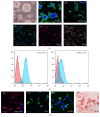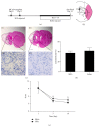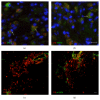Skin-derived precursor cells promote angiogenesis and stimulate proliferation of endogenous neural stem cells after cerebral infarction
- PMID: 25883981
- PMCID: PMC4391522
- DOI: 10.1155/2015/945846
Skin-derived precursor cells promote angiogenesis and stimulate proliferation of endogenous neural stem cells after cerebral infarction
Abstract
Stroke is one of the most common diseases that caused high mortality and has become burden to the health care systems. Stem cell transplantation has shown therapeutic effect in ameliorating ischemic damage after cerebral artery occlusion mainly due to their neurogenesis, immune regulation, or effects on the plasticity, proliferation, and survival of host cells. Recent studies demonstrated that skin-derived precursor cells (SKPs) could promote central nervous system regeneration in spinal cord injury model or the neonatal peripheral neuron. Here, we investigated the therapeutic potential of SKPs in a rat model of cerebral ischemia. SKPs were isolated, expanded, and transplanted into rat cortex and striatum after transient middle cerebral artery occlusion. Our results revealed that SKPs transplantation could improve the behavioral measures of neurological deficit. Moreover, immunohistology confirmed that SKPs could secrete basic FGF and VEGF in the ischemic region and further markedly increase the proliferation of endogenous nestin(+) and βIII-tubulin(+) neural stem cells. Furthermore, increased angiogenesis induced by SKPs was observed by vWF and α-SMA staining. These data suggest that SKPs induced endogenous neurogenesis and angiogenesis and protected neuron from hypoxic-ischemic environment. In conclusion, SKPs transplantation may be a promising approach in treatment of stroke.
Figures





Similar articles
-
Transplanted human embryonic neural stem cells survive, migrate, differentiate and increase endogenous nestin expression in adult rat cortical peri-infarction zone.Neuropathology. 2009 Aug;29(4):410-21. doi: 10.1111/j.1440-1789.2008.00993.x. Epub 2009 Jan 6. Neuropathology. 2009. PMID: 19170896
-
Effect of integrin combined laminin on peripheral blood vessel of cerebral infarction and endogenous nerve regeneration.J Biol Regul Homeost Agents. 2015 Jan-Mar;29(1):167-74. J Biol Regul Homeost Agents. 2015. PMID: 25864754
-
Human embryonic neural stem cell transplantation increases subventricular zone cell proliferation and promotes peri-infarct angiogenesis after focal cerebral ischemia.Neuropathology. 2011 Aug;31(4):384-91. doi: 10.1111/j.1440-1789.2010.01182.x. Epub 2010 Dec 22. Neuropathology. 2011. PMID: 21175862
-
[Therapeutic application of cell transplantation and increased neurogenesis in cerebral infarction].Rinsho Shinkeigaku. 2004 Nov;44(11):756-9. Rinsho Shinkeigaku. 2004. PMID: 15651283 Review. Japanese.
-
Prospective use of skin-derived precursors in neural regeneration.Chin Med J (Engl). 2012 Dec;125(24):4488-96. Chin Med J (Engl). 2012. PMID: 23253725 Review.
Cited by
-
Sonic hedgehog signalling regulates the self-renewal and proliferation of skin-derived precursor cells in mice.Cell Prolif. 2018 Dec;51(6):e12500. doi: 10.1111/cpr.12500. Epub 2018 Aug 27. Cell Prolif. 2018. PMID: 30151845 Free PMC article.
-
Rapid isolation and expansion of skin-derived precursor cells from human primary fibroblast cultures.Biol Open. 2017 Nov 15;6(11):1745-1755. doi: 10.1242/bio.025130. Biol Open. 2017. PMID: 29141956 Free PMC article.
-
Impact of Progerin Expression on Adipogenesis in Hutchinson-Gilford Progeria Skin-Derived Precursor Cells.Cells. 2021 Jun 25;10(7):1598. doi: 10.3390/cells10071598. Cells. 2021. PMID: 34202258 Free PMC article.
-
Angiogenesis after ischemic stroke.Acta Pharmacol Sin. 2023 Jul;44(7):1305-1321. doi: 10.1038/s41401-023-01061-2. Epub 2023 Feb 24. Acta Pharmacol Sin. 2023. PMID: 36829053 Free PMC article. Review.
-
Stem Cell Repair of the Microvascular Damage in Stroke.Cells. 2020 Sep 11;9(9):2075. doi: 10.3390/cells9092075. Cells. 2020. PMID: 32932814 Free PMC article. Review.
References
Publication types
MeSH terms
LinkOut - more resources
Full Text Sources
Other Literature Sources
Miscellaneous

